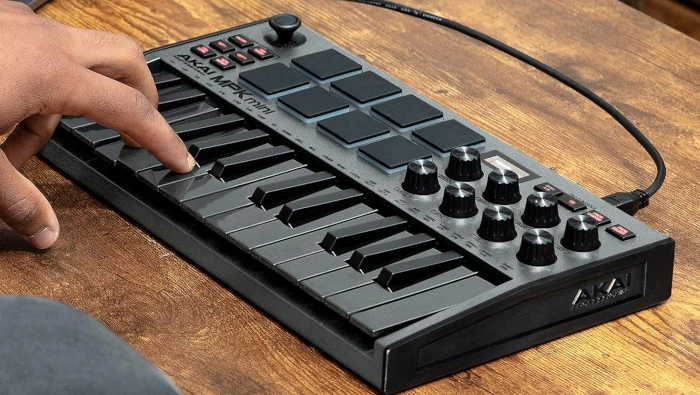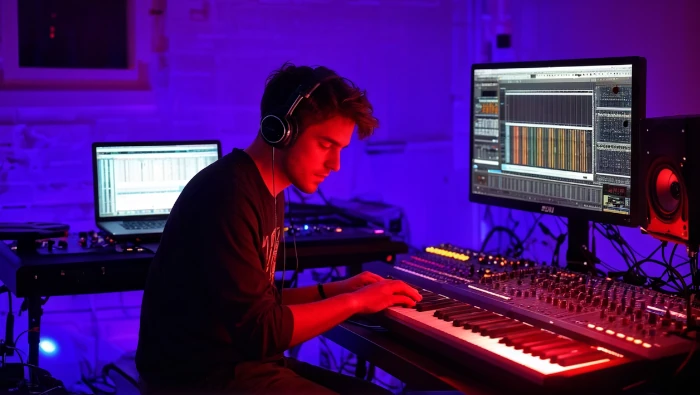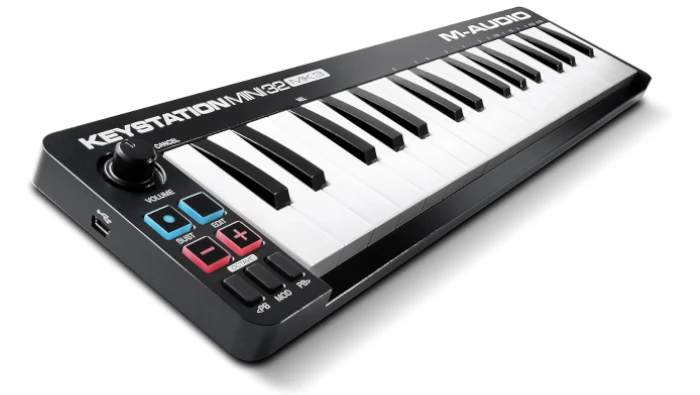MIDI controllers and interfaces are essential tools for modern music production. MIDI, or Musical Instrument Digital Interface, is a technical standard that allows electronic musical instruments, computers, and other devices to communicate and synchronize with each other. The MIDI controllers send performance data, such as notes played on a keyboard or drum hits on a pad, to computers or other instruments, which then produce sound. Meanwhile, MIDI interfaces act as the bridge between your instruments and your computer, ensuring smooth data transfer.
Importance in Home Studios
MIDI devices are crucial for creating professional-quality music at home. They bridge the gap between physical instruments and digital audio workstations (DAWs). With MIDI controllers, musicians can play and record music with tactile feedback, adding a layer of expressiveness that can be challenging to achieve with a mouse and keyboard alone. Additionally, MIDI interfaces expand the connectivity of your studio, allowing multiple devices to work together seamlessly.
Brief History and Evolution
Since its introduction in the early 1980s, MIDI has revolutionized the music industry. Initially, it provided a standardized method for different electronic instruments to communicate, which was a groundbreaking advancement at the time. Over the years, MIDI technology has evolved, incorporating more sophisticated features and improving compatibility with a wide range of devices. Today, MIDI continues to be a foundational element in both professional and home studios, enabling complex compositions and innovative soundscapes. If you’re looking to understand more about how MIDI technology can enhance your home studio setup, explore the best MIDI controllers for comprehensive insights.
Choosing the Right MIDI Controller

Types of MIDI Controllers
When it comes to MIDI controllers, there are several types to choose from, each catering to different aspects of music production. Keyboard controllers are the most common, featuring piano-like keys that are perfect for playing melodies and chords. Pad controllers, on the other hand, are equipped with velocity-sensitive pads that are ideal for triggering drum samples and loops. For those who play wind or string instruments, there are specialized wind controllers and guitar controllers that mimic the feel of their respective traditional instruments.
Factors to Consider
Selecting the right MIDI controller depends on several factors. First, consider your musical needs and the type of music you produce. Keyboard controllers are versatile and suitable for most genres, while pad controllers are excellent for electronic and hip-hop music. Next, think about the features you require. Some controllers come with additional knobs, sliders, and buttons that can be mapped to various functions in your digital audio workstation (DAW), providing greater control over your music production process.
Budget is another crucial factor. Entry-level controllers are affordable and great for beginners, while professional-grade controllers offer more features and higher build quality, catering to experienced musicians and producers. It’s also important to ensure compatibility with your DAW and other equipment in your studio setup.
Recommendations
For beginners, the Akai MPK Mini MK3 is a fantastic choice. It’s compact, affordable, and loaded with features like 25 velocity-sensitive keys, eight backlit pads, and eight knobs. Intermediate users might prefer the Novation Launchkey 49, which offers a larger keybed, more pads, and seamless integration with Ableton Live. For professional users, the Native Instruments Komplete Kontrol S61 provides a premium experience with semi-weighted keys, an extensive range of controls, and deep integration with Komplete software.
Choosing the right MIDI controller is a personal decision that should align with your music production needs, budget, and studio setup. Take the time to research and test different models to find the perfect fit for your creative workflow.
Setting Up Your MIDI Interface
Connecting Your Equipment
Setting up a MIDI interface is a straightforward process, but it requires attention to detail to ensure everything works seamlessly. Start by connecting your MIDI controller to the MIDI interface using a standard MIDI cable. If you have a USB MIDI controller, simply connect it directly to your computer via a USB cable. Ensure that all cables are securely plugged in to avoid any connection issues.
Software Configuration
Once the hardware is connected, the next step is to configure your digital audio workstation (DAW) to recognize and communicate with the MIDI interface. Open your DAW and navigate to the MIDI settings or preferences section. Here, you should see an option to select your MIDI interface as the input and output device. Make sure to enable the MIDI ports associated with your interface.
Driver Installation
Some MIDI interfaces require specific drivers to function correctly. Check the manufacturer’s website for the latest drivers and installation instructions. Install these drivers before connecting your MIDI interface to your computer. This step ensures that your operating system recognizes the device and can communicate with it effectively.
Testing Your Setup
After configuring your DAW and installing necessary drivers, test your setup to confirm everything is working correctly. Create a new project in your DAW and add a MIDI track. Select your MIDI interface as the input source for the track. Play a few notes on your MIDI controller and check if the DAW receives the MIDI data. If everything is set up correctly, you should see the MIDI activity indicator light up in your DAW.
Troubleshooting Common Issues
Sometimes, you might encounter issues during the setup process. If your DAW doesn’t recognize the MIDI interface, double-check all connections and ensure that the interface is powered on. Restarting your computer can also resolve some connectivity issues. Additionally, refer to the user manual for specific troubleshooting tips related to your MIDI interface model.
For more detailed guidance on setting up your studio equipment, explore how to set up your audio and MIDI interface.
Optimizing Performance
To optimize performance, ensure your computer meets the minimum system requirements for your DAW and MIDI interface. Close unnecessary background applications to free up system resources. Regularly update your DAW and MIDI interface drivers to benefit from performance improvements and bug fixes.
Setting up your MIDI interface correctly is crucial for a smooth music production experience. With the right connections and configurations, your MIDI setup will provide a reliable foundation for creating and recording music.
Integrating MIDI in Music Production

Recording MIDI
MIDI recording is a powerful tool that allows for precise control over your musical compositions. To start, create a new MIDI track in your digital audio workstation (DAW). Select your MIDI controller as the input source, and arm the track for recording. As you play your controller, the DAW captures the MIDI data, including note velocity, duration, and other performance nuances. Unlike audio recordings, MIDI data can be easily edited. You can adjust the timing, change notes, and even alter the instrument sound without re-recording, making MIDI incredibly versatile for refining your music.
Using MIDI for Automation
One of the standout features of MIDI is its ability to automate various parameters within your DAW. Automation allows you to dynamically control volume, panning, effects, and more throughout your track. For instance, you can use MIDI to automate a filter sweep, gradually changing the cutoff frequency over time to create movement and interest in your music. By assigning MIDI controls to different parameters, you can bring a performance-like quality to your productions, adding depth and expressiveness.
Layering and Arranging
MIDI is excellent for layering different instruments and arranging complex compositions. Start by recording a basic melody or chord progression. Then, add additional MIDI tracks for basslines, drum patterns, and other elements. With MIDI, you can easily copy, paste, and rearrange sections to experiment with different arrangements. This flexibility speeds up the creative process and allows for quick iterations.
Integrating External Hardware
If you have external synthesizers or drum machines, MIDI can integrate them into your production setup. Connect your external hardware to your MIDI interface using MIDI cables. In your DAW, set up a MIDI track to send data to the external instrument. This setup allows you to sequence and control hardware synths directly from your DAW, combining the best of both digital and analog worlds.
Editing and Quantizing
Editing MIDI data is straightforward and powerful. You can manually adjust note positions, lengths, and velocities in the MIDI editor of your DAW. Quantizing is another crucial feature, which snaps notes to a specified grid, correcting timing issues and ensuring a tight performance. Quantizing can be applied to entire tracks or selectively to maintain a natural feel while tightening the overall rhythm.
Using MIDI Effects
MIDI effects, such as arpeggiators and chord generators, can add complexity and variation to your music. An arpeggiator automatically plays a sequence of notes based on the chords you hold on your MIDI controller, creating intricate patterns with minimal effort. Chord generators can instantly create rich harmonies by transforming single notes into full chords, enhancing your compositions.
For a deeper dive into how MIDI can enhance your music production, discover how MIDI can help you to make a musical arrangement in 2 hours..
Troubleshooting Common MIDI Issues
Connectivity Problems
Connectivity issues are a common challenge when working with MIDI. If your digital audio workstation (DAW) doesn’t recognize your MIDI device, start by checking all physical connections. Ensure that cables are securely plugged in and that the MIDI interface is powered on. If you’re using a USB MIDI controller, try connecting it to a different USB port on your computer. Sometimes, a simple restart of your DAW or computer can resolve connectivity issues.
Driver and Firmware Issues
Outdated drivers or firmware can cause communication problems between your MIDI device and your computer. Visit the manufacturer’s website to download and install the latest drivers for your MIDI interface or controller. Additionally, check if there are any firmware updates available for your hardware. Keeping your software up to date ensures compatibility and can fix bugs that might be causing issues.
Latency Problems
Latency, the delay between pressing a key and hearing the sound, can be frustrating. To reduce latency, adjust your DAW’s buffer size settings. A smaller buffer size decreases latency but can increase the CPU load, so find a balance that works for your system. Also, ensure that you’re using an ASIO driver on Windows or the Core Audio driver on Mac, as these drivers are optimized for low-latency performance.
MIDI Mapping Issues
Incorrect MIDI mapping can prevent your controller from working as intended. Verify that the MIDI channels and control assignments in your DAW match those on your MIDI controller. Most DAWs have a MIDI learn function that simplifies the process of assigning controls. Consult your DAW’s manual for specific instructions on MIDI mapping.
Inconsistent Velocity Response
If your MIDI controller’s keys or pads are responding inconsistently, try recalibrating the device if it offers that option. Also, check for any available sensitivity settings that can be adjusted. Cleaning the contacts under the keys or pads can sometimes resolve these issues as well.
Software Conflicts
Sometimes, other software running on your computer can interfere with MIDI communication. Close any unnecessary applications, especially those that might also use MIDI devices, such as other DAWs or MIDI utilities. This frees up system resources and reduces the likelihood of conflicts.
Power Supply Issues
Some MIDI devices, especially those that draw power from a USB connection, may not function correctly if they’re not receiving enough power. If you’re using a USB hub, ensure it’s a powered hub. Directly connecting your MIDI device to your computer’s USB port can often resolve power-related issues.
Advanced Troubleshooting
For persistent issues, consult the user manuals for both your MIDI device and DAW. Many manufacturers provide detailed troubleshooting guides and support resources. Online forums and user communities can also be valuable sources of information and advice from other users who might have faced similar issues.
If you continue to experience problems, it might be helpful to revisit your setup.
Advanced MIDI Techniques

MIDI Mapping
MIDI mapping is a powerful technique that assigns specific controls on your MIDI device to various parameters in your digital audio workstation (DAW). This customization allows for a more intuitive and efficient workflow. For example, you can map a knob on your MIDI controller to adjust the cutoff frequency of a synth filter or assign a pad to trigger a specific sample. Most DAWs offer a MIDI learn function, simplifying the mapping process. By personalizing your MIDI mappings, you can tailor your setup to suit your production style and workflow.
Using Multiple MIDI Devices
Integrating multiple MIDI devices into your setup can expand your creative possibilities. To do this, connect each MIDI device to your MIDI interface, ensuring that each one is assigned a unique MIDI channel. This setup allows you to control different instruments or parameters simultaneously. For instance, you could use a MIDI keyboard to play melodies while using a pad controller to trigger drum samples. Properly managing your MIDI channels and devices helps prevent conflicts and ensures smooth operation.
MIDI Sequencing
MIDI sequencing involves programming sequences of notes and events to be played back automatically. This technique is especially useful for creating complex, repetitive patterns, such as arpeggios, basslines, and drum loops. Most DAWs include a MIDI sequencer or step sequencer that allows you to input and edit note sequences. By experimenting with different sequences and playback settings, you can create intricate and dynamic musical passages.
MIDI Effects
MIDI effects can transform and enhance your MIDI data in creative ways. Common MIDI effects include arpeggiators, which break down chords into rhythmic patterns, and chord generators, which create harmonies from single notes. Other effects, like MIDI echo and randomization, can add variation and complexity to your sequences. Applying these effects can lead to new and inspiring musical ideas.
Layering and Splitting
Layering and splitting are advanced techniques that involve assigning different sounds or instruments to specific ranges of your MIDI controller. The Layering allows you to play multiple sounds simultaneously, such as a piano and a string ensemble, by pressing a single key. Splitting divides your controller into different zones, each controlling a different sound or instrument. For example, the lower keys could trigger a bass synth, while the upper keys control a lead synth. These techniques can create richer and more complex arrangements.
MIDI Automation
MIDI automation involves recording changes in parameters over time, adding dynamic variation to your music. This can include volume fades, filter sweeps, or pan shifts. By automating these changes, you can bring a more human touch to your productions. Most DAWs allow you to draw automation curves or record parameter changes in real-time using your MIDI controller. This flexibility enables precise control over the expressive elements of your music.
Custom MIDI Scripts and Plugins
For those with programming skills, creating custom MIDI scripts or using third-party plugins can unlock even more potential. Custom scripts can automate repetitive tasks, create unique mappings, or introduce new functionalities not available in your DAW. Many DAWs support scripting languages like Python or JavaScript, and there is a vast array of third-party MIDI plugins available that offer specialized features and enhancements.
By exploring and implementing these advanced MIDI techniques, you can significantly enhance your music production workflow and creativity. For more insights on how to integrate advanced MIDI techniques into your setup, enhance your setup with advanced MIDI techniques.
Conclusion
MIDI controllers and interfaces have revolutionized the way music is produced, offering unparalleled flexibility and control. Whether you’re a beginner setting up your first home studio or a seasoned producer looking to expand your toolkit, understanding how to choose, set up, and utilize MIDI equipment is crucial. From basic connectivity and configuration to advanced techniques like MIDI mapping and automation, these tools can significantly enhance your creative process.
Key Takeaways
- Essential Tools: MIDI controllers and interfaces are indispensable for modern music production, providing a bridge between physical instruments and digital workstations.
- Versatility: Different types of MIDI controllers cater to various aspects of music production, from keyboards for melodies to pads for beats.
- Integration: Properly setting up and integrating MIDI devices ensures a smooth workflow, allowing for complex compositions and real-time performance adjustments.
- Advanced Techniques: Exploring advanced MIDI techniques like sequencing, automation, and custom scripting can take your music production to the next level.
Further Resources
For those eager to dive deeper into the world of MIDI and home studio setups, exploring additional resources can be incredibly beneficial. Topics like optimizing your studio’s acoustics, choosing the best recording software, and mastering audio mixing are just a few areas to consider.
By leveraging the full potential of MIDI technology, you can transform your musical ideas into professional-quality productions. Embrace the power of MIDI and let your creativity soar.

